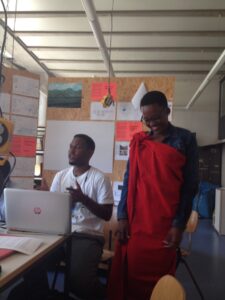WEEK 1 – URBAN HERITAGE IN BERLIN
As we are beginning the second week of the second Simulizi Mijini Summer School, orienting our focus on the interactions between African art and migration with Berlin’s urban heritage, it is also time to come back on the first week of the programme:
DAY 1 – Monday, August 29th
Anne-Katrin Fenk led the group on a walk through the city, from the Märchenbrunnen (the first public park in Berlin, populated by statues of fairies and mythical creature inspired by the tales of the Grimm brothers) to the Prinzessinengarten (a semi-public urban gardening space, which features agriculture, workshops and community events on a large empty lot that was reclaimed by a group of activists in the mid-2000s).
The route is quite simple: from the park, join Lichtenbergstr. where you will notice tall, modern social housing built by the Soviets in the 1950s onwards. A famous one, called the Boomerang, experiments with the use of prefabricated concrete boxes in a way that the building unravels in a curve rather than a square corner.
[googlemaps https://www.google.com/maps/embed?pb=!1m14!1m12!1m3!1d2602.7205881222053!2d13.428698596924285!3d52.52303078984!2m3!1f0!2f0!3f0!3m2!1i1024!2i768!4f13.1!5e1!3m2!1sen!2sde!4v1474368929544&w=600&h=450]
The tour then follows Lichtenbergstr. all the way South, crossing the former Stalinallee, bordered by imperial-looking, tile-covered luxury buildings made for the administrative elite of the DDR. You will walk through the once decimated neighbourhood of Friedrichschain, where have now sprung up dozens of “Plattenbau” (flat buildings) as the Eastern solution for the Wohnungsfrage (“housing issue”).
Further south, the river bridge spans across the area of Holzmarkt, a space reclaimed by activists and anarchists from the 1990s onwards as a space for community gatherings and unconventional housing, questioning the necessity for private ownership in the city, from the tradition of squatting which was so widespread in Berlin until recently. Directly across, the residents of Urban Spree have also established a new mode of property, forming associations and purchasing the land collectively to build modest yet comfortable buildings where there is also room for a bike workshop, art gallery, common kitchen, and play areas.
On the other side of the Spree, Michaelkirschstr. stands half-destroyed, haunting memory of the war where climbing plants are now reclaiming their territory. Right beside it, used to run the famous wall of Berlin, now marked by an unusually wide empty space –the Bethaniendamm.
DAY 2 – Tuesday, August 30th – History in the city, officially
Märkisches Museum –so-called “city museum” of Berlin, it was founded in 1879 to showcase different possible kinds of architecture in one construction and to archive the objects and memories of residents of Berlin and its region, the March of Brandenburg. Most of the collections refer to Berlin pre-war, and come from donations of wealthy families, which draws a limited portrait of this Berlin.
Stadtmodell -gigantic 3D models of the city, showcasing urban plans as well as past realities. Information about this exhibition space can be found on the Berlin senate website.
FHXB Museum -this museum, based in “Little Istanbul”, is the result of local activism and community participation. It tells the story of Kreuzberg and Friedrichschain, two of the poorest neighbourhoods in Berlin, which used to be separated by the wall. Because of their proximity to the wall, they were highly undesirable and neglected by the city governments on both sides, allowing for new types of community organisation, models of property and ownership, immigration and intense cultural creation.

DAY 3 – Wednesday, August 31st – Narratives in the city: objects of heritage
Workshops and studio time with the students, bringing together previous research (summer school in Dar, research studio in Berlin) as well as personal narratives of heritage. The first assignment for the students was to select an object and tell the story of the area where it was made or came from or is used, through urban narratives. We’re looking at the way artefacts can illustrate specific cultural qualities, rituals, skills, and mentalities in ways that tell the story of urban evolution.
For instance, here, the Red Checkered Cloth brought by Michael is an industrial version of the traditional garments made and worn by Massai tribes in Northern-Central Tanzania. In the 1950s, the textile industry started to develop in Tanzania under the economic and administrative influence of the British, and it continued to slowly develop after independence. Massai patterns and color coordination became elements of a new urban fashion growing from Dar es Salaam.
 DAY 4 – Thursday, September 1st – Heritage as archive, communicated
DAY 4 – Thursday, September 1st – Heritage as archive, communicated
Workshop and studio time with guest, professor Marian Dörk, from the Urban Futures Institute for Applied Research, considering questions such as –how do you visually represent a collection of artistic of research pieces? how to handle the problems of curation and narration? how to crossreference items and leave the archive open for future contributions?
DAY 5 – Friday, September 2nd – Editorial day
Workshop and studio time to edit, proofread, link the narratives from summer school and research studio productions.

Sunday, September 4th – Visit to the Bauhaus Dessau





